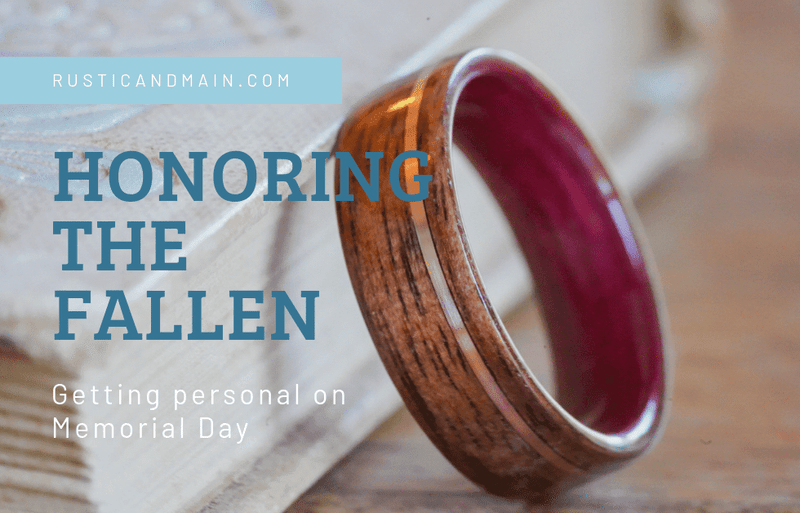Honoring the Fallen - Getting Personal on Memorial Day
May 25 2019 – Mike Yarbrough

Thankfully, there are several days throughout the year to nationally honor our military. So, what is the difference between Memorial Day (last Monday in May), Veterans Day (Nov. 11), Armed Forces Day (third Saturday in May), and Purple Heart Day (Aug. 7)? In short, Memorial Day honors fallen U.S. service members; Veterans Day honors all who have served in the U.S. military; Armed Forces Day honors those who are currently serving in the U.S. military; and finally, Purple Heart Day honors those wounded or killed in battle.
Historically, as a way to honor and remember the fallen after the Civil War (1861-1865), people began placing flowers and flags on the graves of soldiers. This annual ritual of remembrance became known as Decoration Day. And in 1971, Memorial Day became a National holiday of remembrance to honor all U.S. service members who died during battle.
People tend to honor those who contribute to the lives of others. In essence, it reveals some sort of collective appreciation by the multitudes. Being “killed in battle” is a distinct and profound contribution to others, as we have heard, “Greater love has no one than this: that he lay down his life for his friends.”
What is Gained in a Loss?
In order to honor the sacrifice of a fallen veteran, a person would have to be aware of what is gained by such a loss. With previous generations, the benefits and founding principles of our nation were clearer, as the country was younger. Granted, our country has an imperfect past regarding the application of such principles, however, when applied consistently, they are quite extraordinary. Thus, it is the task of the rest of us to exemplify the principles of liberty and justice. The sacrifices have provided a framework and opportunity for which improvement becomes possible because freedom to live them out is possible.
As a former Mental Health Counselor, I value Grief and Loss rituals because they are incredibly helpful for people who have lost loved ones. The ritual gives something positive to look forward to each year, a way to include those precious and valuable lives. The reason this is so powerful is because they still have a place in our lives, a very real place. Rituals of remembrance provides a way to grieve, celebrate, and honor those who are no longer here. In other words, rituals create a new kind of connection or context that allows the fallen to remain part of our lives.
I believe that we should look deeper into the impact of one life sacrificed. Each person was someone’s child, sibling, spouse, or friend. So, when we consider a life lost, it’s not just one single event affecting one single person. The pain of the loss is perpetual for immediate family and friends. Thus, entire families suffer due to the noble actions of one, and the rest of us reap the benefits, often without giving consideration to what that one life meant, and what it still means today.
This Memorial Day, let's honor by remembering the life, loss, and benefits bestowed to us as a whole.

My g-uncle, Sgt. Sam “Buck” Stowe Jr. (1922-1944) and his fiancée, Louetta
Buck enlisted in the Army National Guard in 1940, at age 18. He served in England and France with the 2nd Battalion (Co. E), 120th Regiment, and was killed in action on Aug 9, 1944 at the battle of Mortain.
According to 30thinfantry.org, the 30th Infantry Division was made up of National Guard units from North and South Carolina, Georgia and Tennessee. During WW2, the 30th Infantry Division served in Europe with distinction, and was designated as the #1 Infantry Division in the European Theater by Gen. Eisenhower's Chief Historian, Col. S.L.A. Marshall.
I will not attempt to paraphrase the written experience of soldiers in combat, because it would be incomparable to the eyewitness account. Hence, the following is an excerpt written by a Commander who was present at the 6-day battle against German forces. The first portion quoted is what occurred on the exact day uncle Buck was killed.
In order to provide a basic context, I will preface with this: Hitler ordered a counter-attack shortly after D-Day. Our soldiers were isolated and significantly outnumbered by the Germans.
Operations of the 2nd Battalion, 120th Infantry
(30th Infantry Division) at Mortain, France
6 – 12 August 1944
(Northern France Campaign)
(Personal Experiences of a Company Commander)
An Isolated Infantry Battalion
Defending a Key Terrain Feature
Major Ralph A. Kerley
9 August: Surrender Ultimatum
"Attempts by the regiment and the remainder of the division to relieve the battalion had failed. The first gnawing pains of hunger and thirst were appearing. The ammunition supply had dwindled to practically nothing. Several of the severely wounded died during the night. The bodies of the dead, both our own and the enemy, were deteriorating fast in the warm August sun, and the stench on the Hill was nauseating. The future looked anything but bright, and morale was on the rapid decline.
In an effort to relieve the situation, supplies were loaded into two of the division artillery liaison planes, with the mission of supplying the battalion. Both of these planes were hit by enemy anti-aircraft fire as soon as they approached the enemy lines. It was apparent that if the battalion was to be supplied by air, it would have to be done by faster aircraft.
Division tried next to schedule a flight of C-47’s for the supply mission. Finally, after four requests were made through slow moving channels, a flight was scheduled for 10 August. This information was relayed to the besieged men, but due to past unpleasant experiences with close supporting air, there was some doubt of success in the minds of the men.
The enemy had no doubt been monitoring our radio and knew the existing situation. At approximately 1800 hours, a German officer approached Company E position under a white flag. He was met by a platoon leader from Company E. The German officer stated that he was an officer of the S.S., and was in a position to offer honorable surrender to the Americans. He further stated that he had admired the stand made by the battalion. He was very careful to point out, however, that the situation was hopeless. He named several of the officers in the Battalion Command group who were captured. He further pointed out that certainly it would be no disgrace to surrender under the circumstances, and promised that the men would be well cared for and the wounded given every possible aid. His last promise was that if his offer was not accepted by 2000 hours, the battalion would be blown to bits. The platoon leader relayed the message to the E Company Commander. Some sources quote E Company Commander as saying that he would not surrender until the last round of ammunition had been fired and the last bayonet broken off in a German belly. Actually the reply wasn’t quite so dramatic. It was short, to the point, and very unprintable!
True to their promise, the enemy launched a strong attack at approximately 2015 hours. The battalion ammunition supply was so low, the enemy encountered little resistance other than our artillery. After the enemy had penetrated the position, the E Company Commander called artillery on his own position. This broke up the attack and the enemy took a severe beating. This success served as a ‘shot in the arm’ to the sagging morale of the men on the Hill."
Outcome
"…The 2nd Battalion, 120th Infantry was completely relieved at 1300 hours, 12 August. The battalion had succeeded in fulfilling its mission, but at a bloody price. The battalion lost a total of 277 men killed, captured and missing in action. It would be impossible to record here the acts of self-sacrifice and personal bravery displayed by the men and officers of the battalion during this period. They were magnificent. Some of these men were rewarded for their actions; some were not… A total of 376 were able to walk off the HILL #314 upon relief on 12 August 1944."
Three-quarters of a century after its World War II battles, an entire division of thousands of National Guard soldiers is up for the highest honor a military unit can receive. The following links include an article (or MP3) regarding aforementioned honors, and WWII photos of the 30th Infantry Division and Battle of Mortain:
https://cpa.ds.npr.org/wunc/audio/2018/11/jay_ww2_honor_feature.mp3
https://www.wunc.org/post/decades-after-wwii-battles-nc-national-guard-unit-top-military-honor
https://www.fayobserver.com/photogallery/NC/20181110/NEWS/111009950/PH/1
A Ring design that Honors our Wounded and Fallen Veterans
Our Purple Heart wood wedding ring shown with yellow gold.
Our Purple Heart wood wedding ring shown with sterling silver
According to USO, “The Purple Heart medal is presented to service members who have been wounded or killed as a result of enemy action while serving in the U.S. military. It’s the oldest military award still presented to American service members.” Rustic & Main honors both the wounded and fallen with our Purple Heart Ring. It is crafted with WWII M1 Garand rifle stock and a Purple Heart wood liner and an offset Yellow Gold inlay. A portion of the proceeds goes to The Independence Fund, which supports severely wounded veterans and their families/caregivers.
 This article was written by Rustic and Main Ring Craftsman, David Lemmond. David is former counselor turned expert ring maker. He has a love for history, particularly genealogy, and philosophy, and makes some of the best BBQ sauce on the planet.
This article was written by Rustic and Main Ring Craftsman, David Lemmond. David is former counselor turned expert ring maker. He has a love for history, particularly genealogy, and philosophy, and makes some of the best BBQ sauce on the planet.
Works Cited and Consulted
A History of Cabarrus County in the Wars (Indexed) [database on-line]. Provo, UT, USA: Ancestry.com Operations, Inc., 2010.
http://ww2today.com/7-august-1944-us-artillery-holds-german-counter-attack-at-mortain
http://www.30thinfantry.org/unit_history_mortain.shtml
https://www.uso.org/stories/2276-8-purple-heart-facts
http://www.usmemorialday.org/?page_id=2
https://www.history.com/topics/holidays/memorial-day-history
https://www.pbs.org/newshour/nation/many-americans-died-u-s-wars



